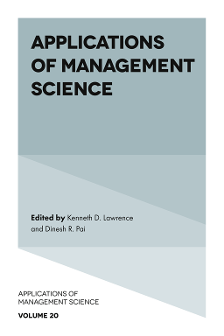
Index
Applications of Management Science
ISBN: 978-1-83867-001-6, eISBN: 978-1-83867-000-9
ISSN: 0276-8976
Publication date: 11 September 2020
Citation
(2020), "Index", Lawrence, K.D. and Pai, D.R. (Ed.) Applications of Management Science (Applications of Management Science, Vol. 20), Emerald Publishing Limited, Leeds, pp. 233-237. https://doi.org/10.1108/S0276-897620200000020018
Publisher
:Emerald Publishing Limited
Copyright © 2020 Emerald Publishing Limited
INDEX
- Prelims
- Section A Applications of Optimization
- Multiobjective Newsvendor Models with CVaR for Flower Industry
- Selected Multiple Criteria Supply Chain Optimization Problems
- Evaluating Consumer Loans Using Machine Learning Techniques
- Use of Maximal Covering Location Problem to Design a Closed Loop Supply Chain Network Under Product Substitution
- Territorial Branding as an Instrument for Competitiveness of Rural Development
- Section B Data Envelopment Analysis Applications
- Developing Composite Indices for Assessing Vulnerability to Floods due to Climate Change: Applying the Order Rated Effectiveness Modeling Method
- A Comparative Analysis of Public and Private Universities in the United States Using Data Envelopment Analysis Models
- Productivity in the US Consumer Drug Store Business
- Section C Data Envelopment Analysis
- Decision-making and Productivity Measurement
- How to Deal with Numbers of Decision-Making Units and Number of Variables in Multiple Input-Output Production Functions
- Evaluating Effective Performance Using Ordered Weighted Averaging and Data Envelopment Analysis Optimization
- Index